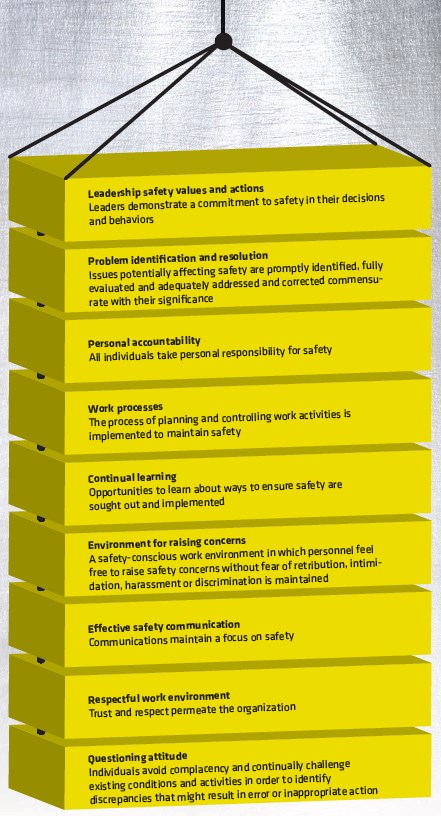by Michelle Karpman — On January 28, 1986 people around the world watched as the Space Shuttle Challenger exploded less than two minutes after lift-off.1 On April 5, 2010, a series of explosions occurred in the Upper Big Branch mine in West Virginia killing 29 coal miners who worked for Performance Coal Company, a subsidiary of Massey Energy Company.2 On April 13, 2011 undergraduate students discovered the dead body of Michele Dufault with her hair tangled in a lathe in Yale University’s Sterling Chemistry laboratory.3
Even though these events seem unrelated, they have one common denominator. They are deadly examples of what occurs when the safety culture within an organization weakens and fails.
What is safety culture?
Safety culture is a sub-component of the culture of an organization. Culture within an organization can be defined as “the way we do things around here” and refers to the factors that influence attitudes and behaviors in organizations. Culture binds together different components and systems within an organization in the pursuit of its mission and goals. Nothing is too trivial or too much trouble for organizations with strong cultures. Every member works to ensure things are done the right way.4
Culture influences and affects behaviors at the individual and group level and includes an organization’s leadership and management style, mission and goals as well as work processes. The culture of an organization is strongly associated with worker perceptions of the performance of day-to-day job tasks in conjunction with organizational functions. Therefore, an organization’s culture directly influences its safety culture.5 The U.S. Nuclear Regulatory Commission’s final Safety Culture Policy Statement defines safety culture as “An organization’s collective commitment, by leaders and individuals, to emphasize safety as an overriding priority to competing goals and other considerations to ensure protection of people and the environment.”6

Need for a strong, positive safety culture and how to build one
The safety culture of an organization is pivotal in promoting the importance of safety to members. Safety is a positive value that prevents injuries, saves lives and improves productivity and outcomes. When an organization’s leadership instills safety as a core value, it nurtures an environment of confidence and caring for all who work online.6
Effective and committed leadership set the direction and strength of the safety culture within an organization. Leadership and management, as a vital key to building a strong safety culture, should seek to: inspire others, seek open and transparent communication, accept responsibility for safety yet hold others accountable, and most importantly, lead by example.6

Building a solid safety culture depends on understanding that safety awareness is a long-term effort where safety is highlighted repeatedly. Organizations can adopt a safety ethic which extols the values of safety such as working safely, preventing risky behavior, promoting safety and accepting responsibility for safety.6
Lessons learned from past mistakes or incidents are useful tools when developing a strong safety culture. Engaging employees in analyzing case studies provide an opportunity for them to think about strategies that could have prevented these incidents. Employees can use these scenarios to determine their role in developing and fostering a positive safety culture within their own organization.6 An excellent resource for real-world case studies in safety culture were developed by the United States Nuclear Regulatory Commission and can be accessed online.2
Developing a positive safety culture further depends on the continued advocacy of a strong safety program. Promoting safety can be as simple as establishing a suggestion box as a system for identifying safety concerns or advertising the importance of safety in newsletters, bulletins or open seminars. Another way to promote positive safety is through a recognition system for good safety performance.6
The role of the facility manager
The role of a facility manager is multifaceted and varies across organizations and sectors. Whether your organization is comprised of two or two thousand, safety culture impacts every aspect of the work environment and interrelates with each of the core competencies of the facility management profession (Figure 1).7
Safety culture should not be confused with environmental and occupational health and safety, as these are programs governed by rules and regulations. Safety culture influences all levels of an organization and is the reflection of an individual’s level of awareness and accountability for safety.5

The one constant in an organization is the concept of change. If facility managers want to build and maintain a positive safety culture, they should understand that the relationship between safety culture perceptions and actual behavior is crucial. The safety culture of an organization, no matter the size or industry is also important for contractors and sub-contractors who work in your facility.
The organization’s safety culture sets the standard for attitudes and behaviors in the facility. When direct employees of the organization and contractors witness management’s commitment to a safe work environment they are more likely to work in a manner which positively impacts the organization’s quality, reliability, competitiveness and profitability. Undoubtedly the best way to build and maintain a positive safety culture within an organization is when the facility manager leads by example (Figure 2).4 FMJ
REFERENCES
- NASA-STS-51L: Mission Archives. Web. 2 Feb. 2014. www.nasa.gov/mission_pages/shuttle/shuttlemissions/archives/sts-51L.html.
- U.S. NRC: Safety Culture. Web. 1 Mar. 2014. www.nrc.gov/about-nrc/regulatory/enforcement/safety-culture.html.
- Foderaro, Lisa W. “Yale Student Killed as Hair Gets Caught in Lathe.” New York Times. 13 April 2011.
- Cooper, Dominic. “Improving Safety Culture: A Practical Guide.” London: John Wiley & Sons, 2001.
- CDC. “CDC Guide-Safety Culture in Hospitals.” Web. 20 Feb. 2014. www.cdc.gov/niosh/stopsticks/safetyculture.html.
- “Creating Safety Cultures in Academic Institutions.” 1st ed. Washington, D.C: American Chemical Society, 2012.
- IFMA. Web. 1 Mar. 2014. www.ifma.org/about/what-is-facility-management.
Michelle Karpman, Ph.D. is a research fellow at the Southwest Center for Occupational and Environmental Health, University of Texas Health Science Center at the Houston School of Public Health. She can be reached at michelle.d.karpman@uth.tmc.edu.